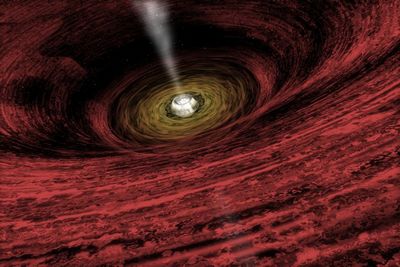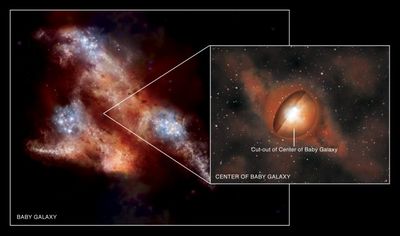
This is an artist's impression of a growing supermassive black hole located in the early Universe, showing a disk of gas rotating around the central object that generates copious amounts of radiation. This gas is destined to be consumed by the black hole. The black hole's mass is less than one hundredth of the mass it will have when the Universe reaches its present day age of about 13.7 billion years.

This artist's impression shows a very young galaxy located in the early Universe less than one billion years after the Big Bang. The distorted appearance of the galaxy is caused by the large number of mergers occurring at this early epoch, and the blue regions mark where star formation is occurring at a high rate. The core of the galaxy is embedded within heavy veils of dust and gas. A cut-out from the core shows that this dust and gas is hiding very bright radiation from the very center of the galaxy, produced by a rapidly growing supermassive black hole.
Using the deepest X-ray image ever taken, astronomers found the first direct evidence that massive black holes were common in the early universe. This discovery from NASA's Chandra X-ray Observatory shows that very young black holes grew more aggressively than previously thought, in tandem with the growth of their host galaxies.
By pointing Chandra at a patch of sky for more than six weeks, astronomers obtained what is known as the Chandra Deep Field South (CDFS). When combined with very deep optical and infrared images from NASA's Hubble Space Telescope, the new Chandra data allowed astronomers to search for black holes in 200 distant galaxies, from when the universe was between about 800 million to 950 million years old.
"Until now, we had no idea what the black holes in these early galaxies were doing, or if they even existed,” said Ezequiel Treister of the University of Hawaii, lead author of the study appearing in the June 16 issue of the journal Nature. “Now we know they are there, and they are growing like gangbusters."
The super-sized growth means that the black holes in the CDFS are less extreme versions of quasars -- very luminous, rare objects powered by material falling onto supermassive black holes. However, the sources in the CDFS are about a hundred times fainter and the black holes are about a thousand times less massive than the ones in quasars.
The observations found that between 30 and 100 percent of the distant galaxies contain growing supermassive black holes. Extrapolating these results from the small observed field to the full sky, there are at least 30 million supermassive black holes in the early universe. This is a factor of 10,000 larger than the estimated number of quasars in the early universe.
“It appears we've found a whole new population of baby black holes,” said co-author Kevin Schawinski of Yale University. “We think these babies will grow by a factor of about a hundred or a thousand, eventually becoming like the giant black holes we see today almost 13 billion years later.”
A population of young black holes in the early universe had been predicted, but not yet observed. Detailed calculations show that the total amount of black hole growth observed by this team is about a hundred times higher than recent estimates.
Because these black holes are nearly all enshrouded in thick clouds of gas and dust, optical telescopes frequently cannot detect them. However, the high energies of X-ray light can penetrate these veils, allowing the black holes inside to be studied.
|
